In the article you will learn everything about corn - the history and origin of the plant, the benefits and harms of corn, the composition and beneficial properties of cereal for the human body, treatment and use in cooking and other fields, the time and technology of planting and harvesting, as well as cereal products - flour and oil from corn and their use, composition and vitamins, preparation and storage.
From this article you will learn:
Corn: a complete overview and botanical reference
Corn is a genus of plants in the family Cereals (Poaceae), which includes six species. However, in culture, the genus is represented by the only species of Zea mays, which is cultivated worldwide on an industrial scale and is an important food, fodder and industrial crop. Wikipedia
Corn photo
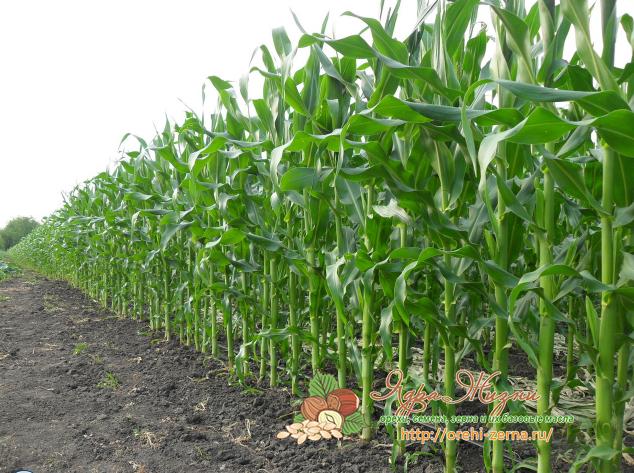 Photo: how corn grows
Photo: how corn grows History of cereal
Which country is the birthplace of corn?
In the botanical classification, corn is a genus of plants belonging to the Cereal family. Moreover, the genus includes six species, of which only one is distributed as an agricultural crop - sweet corn (Zea mays). Today this cereal is one of the most demanded in the world not only as food and fodder, but also as an industrial crop.
It's hard to imagine, but for the Old World, corn did not exist as a plant until it was brought from America by Columbus in the 15th century. At the same time, further studies of the plant indicate that it was grown in Central and South America as far back as 5 thousand years BC. Some scientists, in turn, talk about the cultivation of corn in the territory of modern Mexico about 10 thousand years ago. Even before the times of Columbus, maize had spread widely to both American continents. The northernmost Indian tribe that cultivated corn is considered to be the Laurentian Iroquois, who lived in the vicinity of modern Montreal and Quebec.
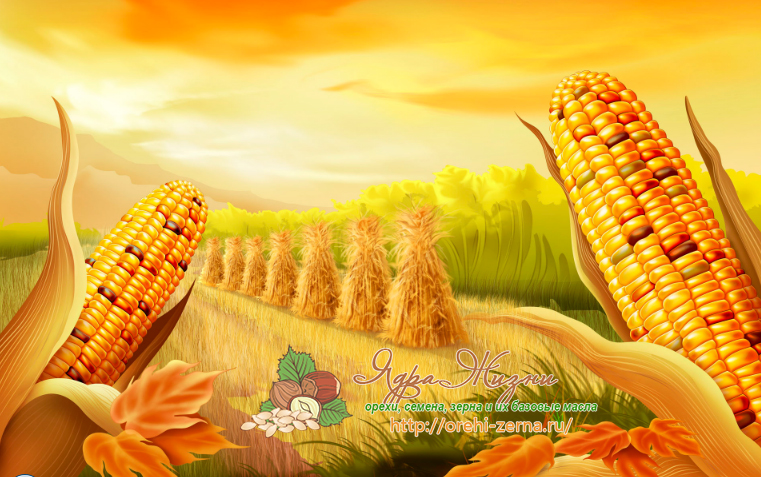
In America, for naming both the plant itself and its products, they use the name "maize", given by the ancient Mayans. It is believed that representatives of this civilization grew several varieties of corn, differing in the size of the cobs and grains, the duration of the growing season, yield and ripening time. Being an extremely important component of the diet, maize for the Indians had the status of a sacred plant, elevated to the level of a deity. Holidays were held in his honor, sacrifices were made.
How corn appeared in Europe
In 1496, maize was among the plants hitherto unknown to Europeans, brought by Columbus from his second trip to the shores of the New World. In Central and Western Europe, the culture has retained its Indian name, but in Russia it is called corn. According to one version, this word is derived from the Romanian cucuruz, translated as "spruce cone", and according to another, from the Turkish kokoros, meaning corn stalk.
The second version is supported by the fact that, firstly, the Russians got acquainted with the plant on the territory of Crimea liberated from the Turks, and secondly, for a long time they called the cereal Turkish wheat or millet. Philologists tend to the Slavic etymology of the word, talking about the similarity of the name with the words meaning "curly" in many Slavic languages.
Thanks to its excellent nutritional qualities and simple care requirements, today "Turkish wheat" is one of the top three cereals in terms of production and consumption. In its historical homeland, it still retains the palm for these indicators and is used for food in a variety of forms.
Corn: Botanical Description
What are the roots of corn
Maize (Zea mays), known in the post-Soviet space under the name of sugar corn, is an annual herbaceous plant. It is the only species in the genus Corn of the Cereal family that grows as an agricultural crop. The genus also has 4 uncultivated plant species, and Zea mays has three wild-growing subspecies. It is assumed that in ancient Mexico, some of them were also grown by man.
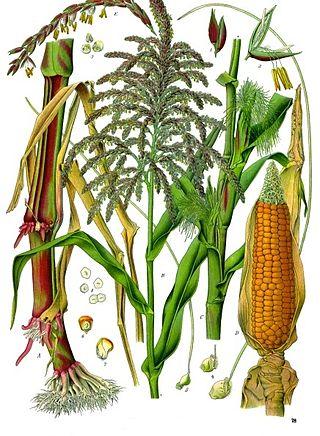 Corn stalks can reach a height of more than three meters. They have a developed root system, which, despite the fibrous shape, deepens by 1-1.5 meters. Sometimes supporting roots grow on the stem near the ground, preventing the plant from falling and also bringing useful substances to it. In diameter, the stems reach 7 centimeters and, unlike most cereals, do not have a cavity inside.
Corn stalks can reach a height of more than three meters. They have a developed root system, which, despite the fibrous shape, deepens by 1-1.5 meters. Sometimes supporting roots grow on the stem near the ground, preventing the plant from falling and also bringing useful substances to it. In diameter, the stems reach 7 centimeters and, unlike most cereals, do not have a cavity inside.
Like a monoecious plant, corn produces same-sex flowers during the growing season. The males are at the tops of the shoots, and the females are in the cob inflorescences located in the leaf axils. Therefore, for independent cross-pollination, it is advised to plant a culture in at least 4 rows. Otherwise, you have to do it manually several times a day, pouring the collected pollen into the open cob germ.
What shoot is removed from corn
Despite the simplicity of self-growing corn, its yield is still affected by the correct care. In Russia, especially in regions with a shorter warm period of the year, a seedling planting method is used. To do this, the shoots after the formation of at least three leaves are transferred to the ground. If the root system was not damaged at this time, the plant will most likely take root well and will require little: timely loosening of the soil, watering, fertilizing and thinning.
After some time, stepchildren are formed on the plant - side shoots 20-25 centimeters long. Usually they are removed, leaving no more than 2-3, because this slows down the growth and development of young cobs, which causes a decrease in yield.
Usually, 1-3 fruit ears weighing 50-350 grams grow on one stem, but there are varieties of corn that produce more of them. A mature fruit like a caryopsis can reach 50 cm in length. The weight of 1000 grains is usually 0.25-0.3 kg, but in some varieties it reaches 0.5 kg. Outside, corn fruits are covered with dense leaf-like wrappers.
Growing. Corn varieties
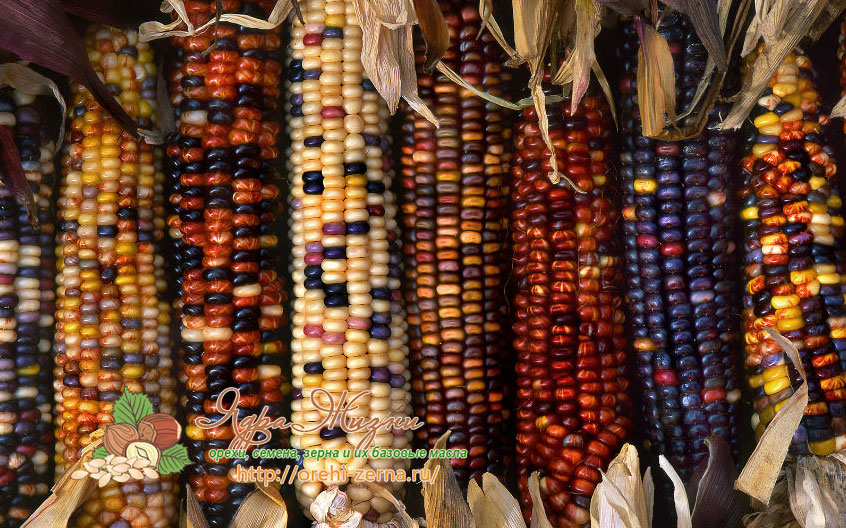 Photo: different varieties of corn
Photo: different varieties of corn As already mentioned, there are no cultivated species of this plant other than maize or sweet corn (Zea mays). However, a certain variety within the species itself is present. According to the current classification, this herbaceous plant includes 10 botanical groups, belonging to which is determined by the structure of the cob or grains and shaping. Food items include:
- Sugar(Zea mays zaccharata). A common variety of corn cultivated on all continents. Fruits have the highest content of sugars and a minimum of starch. It is grown mainly for the industrial production of a canned product. It is also acceptable to boil the forks. Varieties: Aurika, Kuban sugar, Krasnodar sugar 250, Divine paper.
- dentate(Zea mays indentata). This group includes many late-ripening productive corn. They have a vigorous stem and a small volume of foliage. At the foot they form aerial roots. Dents appear on the grains covering massive cobs, making them look like teeth. Tooth varieties of corn are used as a raw material for cereals, flour, alcohol, and also as a fodder crop. Grades: Kadr 443 SV, Dneprovsky 172 MV, Krasnodar 436 MV.
- Siliceous or Indian(Zea mays indurate). The same kind of culture that was brought to Europe. It is actively grown and now all over the world, being one of the most popular varieties. The grains are round, wrinkled, white or yellow, and three-quarters solid starch. Varieties are characterized by high yield and precocity. Flint corn is used to make flakes and sticks and is also grown for grain. Varieties: Cherokee Blue, Maize Ornamental Congo.
- Starchy, soft or mealy(Zea mays amylacea). The grains of this group of varieties are more than 80% composed of starch. Densely leafy bushy plants today grow only in the New World and are used there for the production of alcohol, starch, molasses and flour. Varieties: Mais Concho, Thompson Profile.
- waxy(Zea mays ceratina). A group of hybrids of dent corn, which is characterized by a two-layer storage tissue. The matte outer part is hard and resembles wax, and the middle layer due to amylopectin has a mealy texture. Waxy corn is rare and most popular in China. Varieties: Oaxacan red, Strawberry,
- bursting(Zea mays everta). A group of bushy plants formed by subgroups of rice and barley corn. Their names are due to the taste similarity of grains with the corresponding cereals. The group has a wide range of colors and is widely used for the production of popcorn, but also serves as a raw material for cereals and cereals. Varieties: Red Arrow, Mini Striped.
- Semi-dentate(Zea mays semidentata). It was obtained as a result of crossing dentate and siliceous, therefore it can also be called semi-siliceous. The varieties Rodnik 179 SV and Moldavsky 215 MV are widely used.
Such varieties of corn as filmy, starchy-sugar and Japanese variegated corn have no nutritional value and therefore are either not used for decorative purposes, or are of no industrial interest at all.
Corn benefit and harm
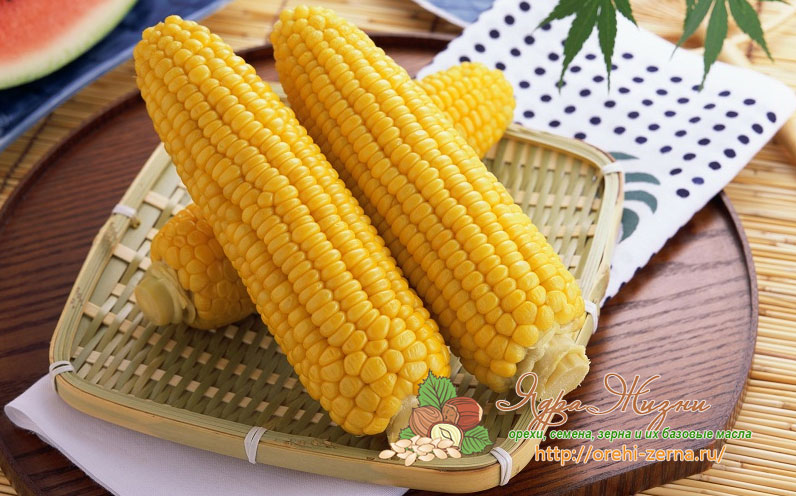 Photo: corn benefit and harm
Photo: corn benefit and harm The chemical composition of corn grains
Corn grains have a rich chemical composition, which includes vitamins A, B, E, H, PP, as well as mineral compounds of more than 20 micro and macro elements.
100 grams of raw product contains a quarter of the daily intake of vitamins B1 and B6, copper, phosphorus and magnesium, as well as about half of the required amount of cobalt, manganese, molybdenum and selenium.
In canned corn, only vitamins B1, B2, C, PP and inclusions of calcium, magnesium, sodium and phosphorus remain from this wealth.
Boiled corn kernels also have a less saturated composition. In addition, corn stigmas contain phylloquinones, carotenoids, steroids, inosides, saponins, and glycoside-like substances. About 10% of the mass of the grains are coarse dietary fibers that help stabilize digestion. This product also has 12 essential and 8 non-essential amino acids.
Calorie content and nutritional value of corn
Speaking about the nutritional base of corn seeds, it should be noted that the exact figures depend not only on whether the product has been processed, but also on the type of raw material. Average caloric and nutritional values are presented in the table.
| type of corn | Protein (g) | Fat (g) | Carbs (g) | Calorie content (kcal) |
| waxy | 10,1 | 5,9 | 66,4 | 324,5 |
| dentate | 8,3 | 4 | 61,4 | 320 |
| starchy | 9,4 | 4,8 | 59,6 | 316 |
| Siliceous | 9,2 | 4,2 | 59,6 | 316 |
| bursting | 11,7 | 4,3 | 66,9 | 336,4 |
| Sugar | 11,9 | 6,5 | 63,6 | 344,6 |
| Fresh on the cob | 10,3 | 4,9 | 67,5 | 338,4 |
| boiled | 4,1 | 2,3 | 22,5 | 123 |
| Canned | 3,9 | 1,3 | 22,7 | 119 |
| Groats | 8,3 | 1,2 | 71 | 328 |
| Flour | 7,2 | 1,5 | 72,1 | 331 |
| Cereals | 8,3 | 1,2 | 75 | 325,3 |
Useful properties of corn for the body
Due to the rich composition of corn grains, the use of products made from them promotes health and improves the functioning of many organs and systems of the human body, both for men and for women and children. It is also useful for pregnant women to use, the restriction of the product in food depends only on personal contraindications.
Useful properties of corn for the body:
- B vitamins are involved in energy production and metabolism regulation. In many ways, due to them, a healthy and beautiful appearance is ensured. The presence of these nutrients is also necessary for a calm and confident work of the nervous system.
- Corn brings vitamin E to the body, which is primarily needed for high-quality anti-cancer immunity. In addition, tocopherol is involved in the work of the nervous, reproductive and circulatory systems, prevents aging. Equally important for anti-carcinogenic prophylaxis is selenium, also contained in corn.
- Calcium is one of the most important elements for the body. Together with phosphorus, it provides strength to teeth and bones, strengthens the nervous system, and is necessary for the growth and strengthening of muscle tissue.
- Due to the presence of magnesium in the composition, eating corn helps to balance the central nervous system, improve heart function, reduce stress factors and prevent some spasms.
- Copper and iron, which enter the body with the product, improve the functioning of the cardiovascular system, normalize the heart rhythm, strengthen the walls of blood vessels, and have an antiseptic effect.
- 100 grams of corn contains half the amount of dietary fiber that you need to consume daily. Thanks to them, intestinal peristalsis is stimulated, its mechanical cleaning is carried out, and blood circulation in the tissues improves.
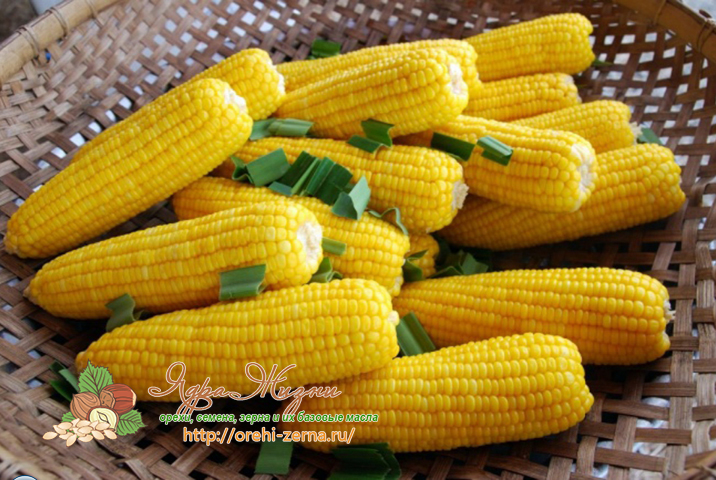 Photo: boiled corn
Photo: boiled corn Medicinal properties for the human body
For many centuries, corn kernels, stigmas, leaves and other parts of the plant have been used with benefit in folk healing practices. The most common form of the medicine is an infusion or extract. In Russia, corn stigma tincture is often used to stimulate bile production in cholecystitis, hepatitis, and other diseases associated with the liver or gallbladder. In addition, herbal preparations from corn stigmas have a diuretic and hypoglycemic effect, therefore they are used in appropriate cases.
Corn oil is advised to take to improve well-being in diseases of the bile ducts, liver, hypertension, edema of cardiac origin and atherosclerosis.
Corn cobs have important medicinal properties, so they do not require special treatment. It is enough just to eat them to enhance the excretion of radionuclides and toxins from the body. The presence of the strong antioxidants mentioned above (tocopherol, selenium) helps in the prevention and treatment of cancer.
Boiled corn helps in the treatment of gout, constipation, nephritis, diseases of the liver and cardiovascular system.
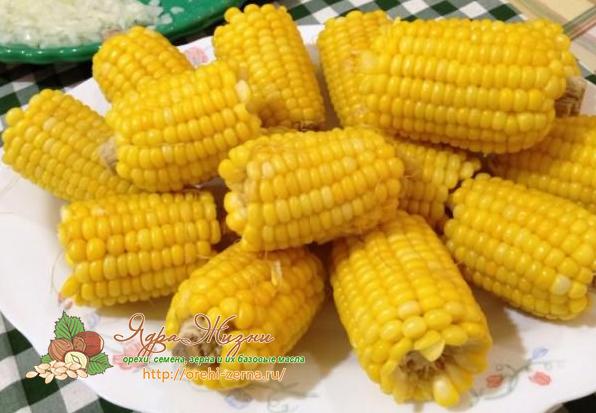 Photo: corn benefits and harm to the body
Photo: corn benefits and harm to the body In folk medicine, corn is used for medicinal purposes to treat the following diseases:
- Glaucoma. It is necessary to brew 15 grams of crushed stigmas with a glass of boiling water and insist for 35-40 minutes. After filtering and cooling, the infusion is applied 1 tablespoon three times a day. Drinking is not recommended.
- Obesity. It is necessary to insist crushed stigmas in boiling water (1:10) for an hour, then strain and cool. When taking 1 tbsp. l. no more than 5 times a day, this remedy reduces appetite and improves metabolism.
- With pancreatitis, a decoction of grains, stigmas and wrappers of white corn in the stage of milky-wax ripeness, taken three times a day, 150-200 ml, helps.
- Diabetes. Take 1 tablespoon of dried and grated immortelle flowers, rose hips and blueberry leaves, as well as 2 tablespoons of cornmeal. The dry mixture is poured into 0.5 liters of boiling water and boiled over low heat for about 5-10 minutes, and then closed for infusion for 60 minutes. After straining, you need to drink 1/3 cup three times a day a quarter of an hour after eating. Treatment regimen: 3 weeks of admission, 3 weeks of rest.
- With urolithiasis, it is recommended to drink a decoction of cornmeal (1 tablespoon per 200 ml of boiling water). After pouring, the drink must be stirred well and closed for infusion for 5-6 hours. Strained broth is taken in 2 tbsp. l. three times a day before meals.
- 2 tablespoons of fresh stigmas pour 200 ml of boiling water, leave for half an hour and strain. With hemorrhoids, inflammation of the appendages, atherosclerosis, hypertension and bleeding during menopause, this decoction should be drunk in a quarter cup three times a day 2 hours after a meal.
Corn oil: benefits and harms, application
Corn oil- A fairly common type of vegetable fat, but not the most popular. This product has similar gastronomic qualities as sunflower oil, but is inferior to it in terms of consumption.
Corn oil is produced by extraction or pressing from grain germ, which makes up no more than 10% of its weight. At the same time, they account for more than 75% of the total share of fat contained in the entire grain, as well as about 20% of proteins and 70% of minerals.
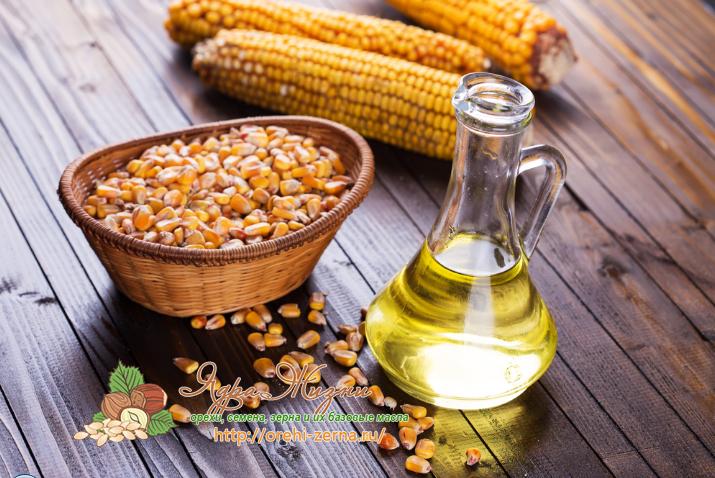 Photo: corn oil
Photo: corn oil There are four types of corn oil, depending on the degree of purification: unrefined, refined non-deodorized, grade D and grade P (both refined deodorized). Brand D oil is intended for the manufacture of dietary and baby food products, and grade P is for use in catering and retail establishments.
Despite its low popularity, corn germ oil can be used for dressing cold dishes, for baking, and for processing food at moderate heat (no more than a smoke point of 232˚C). In addition, it is used in medicine as an anti-sclerotic agent.
Corn juice and its properties
Corn juice is not found commercially, but is produced in fairly large volumes. True, not cobs are used for pressing, but stems and leaves. This part of the plant mainly consists of sucrose.
It should be noted that corn for the production of leafy juice is grown in a slightly different way than fodder or food corn. Cobs are removed from plants before ripeness, which causes sugars to accumulate in the leaves. A few weeks after tearing off the cobs, the culture is processed: the squeezed juice is evaporated into syrup, and the cake and unripe cobs are used in pulp and alcohol production.
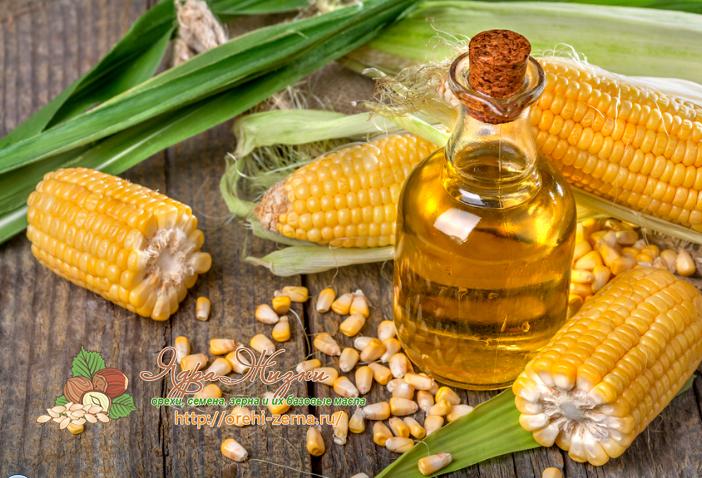 Photo: corn juice
Photo: corn juice Corn juice is sometimes referred to as a syrup made from the same cereal, but in fact it is not juice. Corn syrup is made from starch extracted from the husks and sprouts, and is conventionally divided into two types: light and dark (similar to molasses). The first, as a rule, is used in the manufacture of sweets, and the second - flour products.
Experts speak about the benefits of eating corn syrup ambiguously. Some scientists say that it does not provoke an increase in insulin levels, therefore, it is available for diabetic nutrition.
In confectionery applications, syrup has an advantage over sugar - it does not crystallize, retaining its texture. For example, corn syrup candies don't get tougher and harder, so they don't have to be as hard to crack.
Other researchers refute this point of view, and also say that when using this product, there is no feeling of satiety, since the hormone leptin is not produced. The lobbying of syrup by industrialists is understandable, since this raw material is currently more profitable than sugar.
One way or another, corn syrup is quite high in calories, and its effect on the body has not been fully studied. Therefore, its use should be treated responsibly and moderately.
The use of corn in cooking
Maize has a very wide range of uses in the culinary industry. First of all, ripe corncobs can be eaten fresh, but more often they are boiled. Long-term also keeps it in a fairly good shape, the product does not lose many useful substances. All over the world, canned corn grains are in demand, usually sweet, which are used in the preparation of salads, first and second courses.
In the cuisines of different peoples of the world there are national dishes made from corn grains: in Argentina - locro (meat soup) and humita (corn-curd dish), in Moldova - hominy, in Georgia - mchadi bread, in Central America - tortillas, in China - cornbread. In Mexico, the recipe for making chicha corn beer from germinated grains has survived to this day.
A world-famous delicacy is popcorn, which is made from popping corn. This is one of those products in the production of which it is impossible to replace cereal with any analogue.
Corn flour
No less widely used is corn flour, the maximum consumption of which falls on Mexico and the countries of Central America. In this region, corn flour is the same basis of the diet as wheat flour is in Russia. Cornmeal is used to make bread, confectionery, pastries, puddings, cereals, chips and many other products.
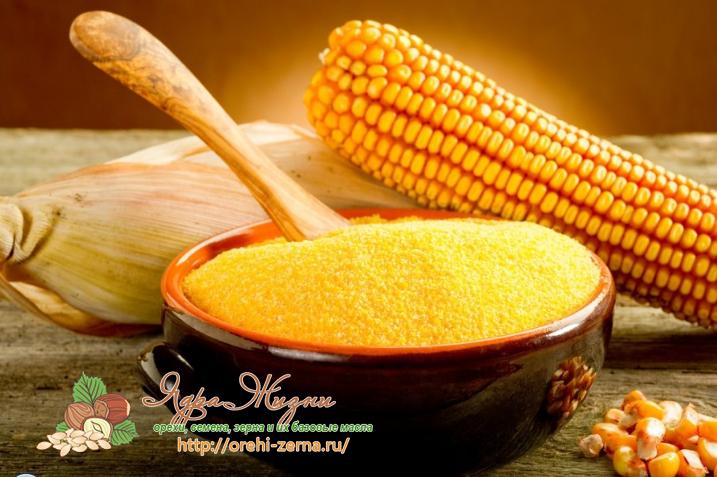 Photo: cornmeal
Photo: cornmeal Corn flour and oil in cosmetology
Among the derivatives of corn in cosmetology, flour and oil obtained from grains are used. Moreover, it is oil that is most in demand, since in itself it has a sufficient composition for active use. Flour, on the other hand, requires the addition of other ingredients, both to enhance the effect and to obtain an accessible form.
The composition of corn flour contains vitamins A, B1, B2, E, PP, mineral compounds of potassium, calcium, manganese, sodium, phosphorus, iron and a small proportion of saturated fatty acids. The complex of these substances provides an antiseptic, nourishing, tonic and cleansing effect. Most often, cornmeal is used for home preparation of acne and acne remedies, as well as for applying anti-cellulite masks after taking a bath.
Corn oil is a more versatile cosmetic raw material and its scope is much wider. In addition to fatty acids necessary for healthy skin (up to 57% of the composition is linoleic, and oleic - up to 24%), the oil also contains alpha tocopherol, also called the vitamin of youth. Its antioxidant properties not only slow down cell aging, but also prevent the activity of free radicals, which are one of the causes of cancer.
Fatty acids nourish, regulate lipid exchange between tissues, stabilize intracellular metabolism, strengthen skin immunity. Corn oil in cosmetology can be used for dry, oily, damaged, aging and sensitive skin of the face and hands. Together with other base and essential oils in home cosmetics, it helps to take care of hair and nails, and also acts as a good massage tool.
The use of corn in other areas
Gastronomy represents a major, but not the only, use of corn in the modern world. In industrial cosmetology, pharmaceuticals and medicine, derivatives of this culture are used very rarely. Much more demanded corn is for agriculture. It is very well suited for animal nutrition, since it significantly outperforms most fodder crops in terms of green mass and yield. In addition, this food is well digested, easily included in the diet, enriching it with carotene. The leafy part of plants remaining after harvesting has no less nutritional value than oats or barley. About 70% of the area of corn crops is occupied by silage varieties cultivated exclusively for cattle feed.
In addition, corn components are used in the manufacture of paint and varnish products and soap products, viscose cloth, paper, building materials and fertilizers. In South and Central America, corn starch is a key raw material in the manufacture of alcohol.
Growing corn at home
The germination of seeds of various cereals is now widely used among supporters of a healthy diet. Corn is no exception - this way of preparing for consumption makes the grains easier to digest and saturates them with useful elements.
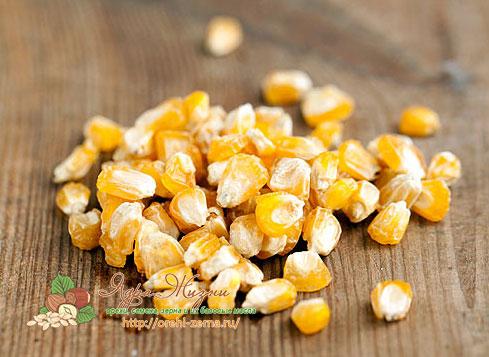
Pre-sowing germination of seeds is also practiced to improve their germination and the germination of cereals for brewing moonshine.
Sprouted corn benefits and harms
Germinated corn kernels contain a large amount of antioxidants. This contributes to the rejuvenation of body tissues, and the protection of their carcinogenic factors.
The chemical composition of germinated corn helps to increase the level of hemoglobin, stabilize blood pressure, and improve vision. Corn sprouts are consumed fresh, scalded with boiling water, in salads, cereals or soups.
How to germinate corn kernels for food
- For germination, low dishes with a large bottom area are taken so that the cereal can be laid out in 2-3 layers.
- Then water is poured to the level of light coverage of the upper grains.
- During germination, the liquid must be changed every 12 hours so that the medium does not fade.
- After a couple of days, the cereal will swell and be ready for use, but grains with green sprouts will be more useful.
The main contraindications for the use of corn and corn oil
Corn kernels are not a universal product suitable for absolutely everyone. In addition to those who have individual intolerance, people with increased blood clotting and thrombosis should be careful with cereal. The fact is that in the composition of the cereal there is a decent proportion of vitamin K, which stimulates blood clotting.
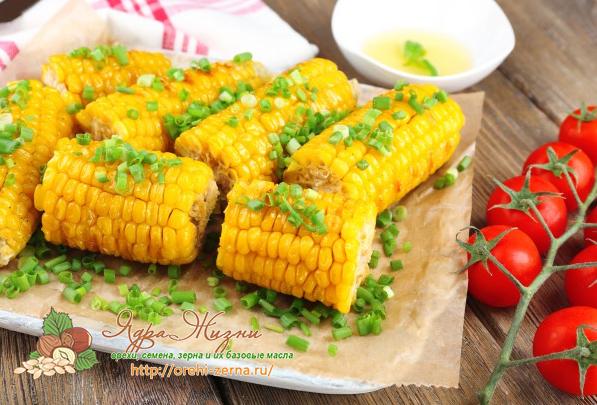
You should also remember about the large amount of dietary fiber. They can cause complications in acute gastrointestinal diseases or intestinal obstruction (although in some cases they also help solve the problem). Irritation of the digestive walls with fibers can aggravate the situation with gastritis, duodenal ulcer or stomach ulcer. The attending specialist will best help determine the possibility of use.
Like many vegetable fats, corn oil is considered safe for everyone except those with individual intolerance. However, it is important to take a responsible approach to the choice of liquid, as a spoiled product may contain harmful oxides and compounds.
Collection, preparation and storage, as well as the expiration date
The time when the corn crop is harvested is chosen based on the characteristics of the plant variety, its purpose, the place of cultivation and the current vegetative characteristics. In Russia, as a rule, sweet corn begins to be harvested in late August or early September. Both fodder and food cereals, after harvesting the cobs, are subjected to primary cleaning, drying and separation from impurities.
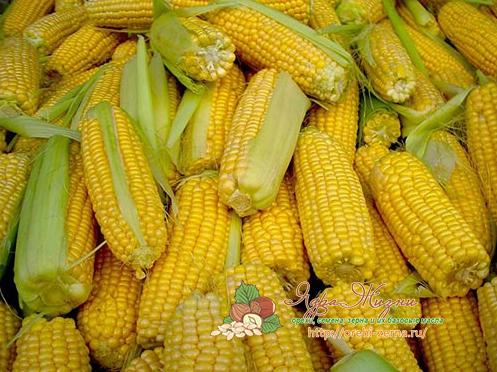
The conditions and technology for storing corn grains can vary greatly, depending on the variety. Dairy corn is stored no more than 3 weeks refrigerated. In industrial production, it is either frozen or canned. To carry out home freezing with your own hands you need:
- Soak the cobs for 20 minutes in a water-salt solution (1 tsp of lemon juice and salt per 1 liter of water).
- Hustle the grain and dry.
- Pack in sealed bags and put in the freezer.
Grain corn in the household is stored in boxes, plastic jars or canvas bags, and in large farms - in elevators at an ambient temperature and humidity of no more than 13%. You can try to achieve similar indicators at home. The seed material is kept in a dry room, stacked, for which sheds or attics are well suited. When stored on the cob, it is necessary to equip the room with a forced ventilation system.
Storing boiled corn
Boiled corn is a popular delicacy that, unfortunately, is not available fresh all year round. Few people know that you can stock up on this simple product for the winter by sending it to the refrigerator after cooking:
- Cobs wrapped in cling film are stored for several days in the refrigerator, retaining their taste and freshness.
- You can put the whole pot in the refrigerator along with water and cobs. Within 2-3 days, the grain will retain its juiciness and taste.
- For long-term storage in the freezer, boiled cobs should be dipped several times alternately in hot and cold water, dried with a napkin and wrapped separately from each other in cling film. The period of such storage is 3 months.
To preserve corn grain, a brine is made with salt and sugar (3 tsp per 1 liter of water). Fresh grains are poured into a sterilized jar and filled to the top with a preservative solution. In addition, you can add your preferred spices to the jar: lavrushka, pepper, basil, paprika, etc.
